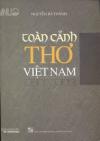
Nguyen Ba Thanh
Hanoi: Vietnam National University Press, 2015
Reviewed by Tran Dang Trung (Ph.D. Candidate, Vietnam National University-Hanoi; 2015-16 HYI Visiting Fellow)
Scholarship on the period of revolution and wars in Vietnam (1945-1975) has been heavily influenced by a Cold War worldview and mentality emphasizing global ideologies, antagonism and exclusiveness. In literary studies, this divisive way of thinking still dominates discourses on the history and development of Vietnamese modern poetry. A Panorama of Vietnamese Poetry: 1945-1975 is a monograph endeavoring to cover the wide variety of poetry created during a tumultuous time and also a scholarly attempt to reconcile opposing ideas and trends into a unified nationalistic framework. Comprehensive in scope, daring in argument, and scrupulous in analysis, the book is a groundbreaking work on the topic.
Excluding its introduction and conclusion, the book is composed of four chapters. Chapter 1 deals with the problem of viewing Vietnamese poetry of the 1945-1975 period as a whole despite the many ruptures, contradictions, and divergences marking literary trends. The author criticizes most of the previous approaches as having overlooked the significance of certain trends and movements of poetry due to political biases, and attempts to provide a more inclusive and balanced view. In chapter 2, the author looks at poetry under the Democratic Republic of Vietnam (North Vietnam), revealing how revolution and wars influenced the mindset of poets and the aesthetics of writing. Influenced by Stalinism and Maoism, poetry was monolithically regarded as a weapon against enemies and a tool for constructing a new nation and promoting new ideal characteristics such as patriotism, collectivism, heroism, and masculine militarism. The dissident poets of the Nhan Van-Giai Pham movement are also discussed in detail. Chapter 3 reevaluates poetry under the State of Vietnam and the Republic of Vietnam (South Vietnam) in an attempt to examine its dynamics and complexity. Here, the author demonstrates the interaction between a long Southern lyrical tradition and Western influences such as the phenomenology of Heidegger, psychoanalysis of Freud, and existentialism of Sartre. Making poetry was seen as an expression of deep consciousness, a hopeless reaction against the absurdity of perennial war, an outcry of loneliness in a highly capitalist society, and a way of protesting American imperial and communist aggressions. Chapter 4 attempts to point out some common features of the heterogeneous Vietnamese poetry of the period. The author argues that the development of poetry in both North and South Vietnam was, in fact, a continuation of the pre-war literary modernization in different directions. Despite these highly divergent expressions, this poetry shares universal themes like the yearning for peace and national unification, as well as similar experiments with form such as the use of free verse and the liberation of language and poetic images.
In short, this book is an admirable effort to draw a full picture of Vietnamese poetry during an extremely divisive period. It should also be read as a humane reconciliation between Vietnamese people from all sides.
